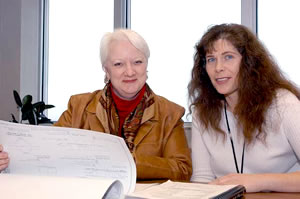 |
|
Diane Langenbach (at right) confers with her supervisor,
Merry Daher, in State Aid to Local Transportation. Photo by David Gonzalez
|
One of Mn/DOTís newly minted graduate engineers grew up in Morocco, earned
university degrees on the East Coast and recently celebrated a baptism of sorts
riding with a Metro District snowplow operator.
Another earned a degree in history, worked for a software company where engineers
predominated and then became an engineer herself.
Most new graduate engineers, though, followed a more traditional routeójoining
the program shortly after earning a bachelorís degree in engineering. But one
of the newest, Dmitry Tomasevich, logged more than two years as a student worker
with the Metro District.
These new graduate engineers and their nine colleagues comprise a well-educated,
experienced and diverse graduate engineer class. This is 24th year of the departmentís
graduate engineer training program, said Jolene Forman, program coordinator,
Workforce Development.
Members of the new class will be assigned to various offices and districts
as they begin the two-year rotation program designed to prepare them for full-time
careers with the department.
 |
|
Dmitry Tomasevich logged more than two years as a student
worker with the Metro District before becoming a graduate engineer. Photo
by David Gonzalez
|
The new graduate class includes three current Mn/DOT employees who have earned
degrees in civil engineering and have several years of work experience as well.
Rebecca Fabunmi recently started her first rotation with the Metro District
Design. Fabumni earned her civil engineering degree in 1997 while participating
in Mn/DOTís Seeds Program.
She worked in Environmental Services, Materials and Research, and Technical
Support as a student worker.
Most experienced among the Mn/DOT graduate engineers is Diane Lagenbach. She
earned her degree from the University of Minnesota in 1993, then joined the
Metropolitan Council as a professional engineer working on environmental issues.
After taking time off to raise her twin sons, now six, Langenbach returned to
work part-time with Mn/DOTís Office of Environmental Services.
Langenbach took a voluntary demotion to graduate engineer to enter the rotation
program. Sheís now on her first rotation in State Aid and considering an assignment
with a city or county as part of her next rotation.
"I decided to make an investment in my career and broaden my perspective
and my options," she said.
 |
|
Graduate engineer Julie Johnson serves her first rotation
with Environmental Services. Photo by David Gonzalez
|
The same could be said for Julie Johnson and Monty Hamri, two of the more experienced
new graduate engineers.
Johnson earned a degree in history in 1993. After graduating, she worked in
customer service for a small computer software company in the Twin Cities. She
said, however, that advancement was made more likely by becoming an engineer,
so she returned to the University of Minnesota and earned a bachelorís degree
in civil engineering in 2003. Sheís now in her first rotation, working in areas
such as erosion control with Environmental Services.
Moroccan native Monty Hamri immigrated to the United States in 1990, then earned
bachelorís and masterís degrees in civil engineering and technology. Hamriís
first exposure to Mn/DOTóand to a Minnesota winterócame this year when he started
his first rotation with Metro in Maintenance Operations.
Hamri hasnít chosen his next rotation, but said his post in maintenance gives
him valuable beginning insight into the departmentís workings.
The recent change in the age and experience levels of graduate engineer candidates
and the need to nurture the careers of Mn/DOT employees led the department to
limit next yearís class to current employees, Forman said.
"We think opening the program only to employees gives internal candidates
a chance to compete and to make the best use of our investment in training people,"
she said. "As it does with the current class, recruiting from within will
help Mn/DOT people broaden their knowledge and experience base and provide opportunities
for career options and growth."
By Craig Wilkins
|



